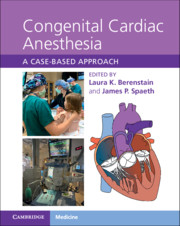Book contents
- Congenital Cardiac Anesthesia
- Congenital Cardiac Anesthesia
- Copyright page
- Dedication
- Contents
- Contributors
- Introduction
- Chapter 1 A Congenital Heart Disease Primer
- Section 1 Left-to-Right Shunts
- Section 2 Right-Sided Obstructive Lesions
- Chapter 6 Critical Pulmonic Stenosis
- Chapter 7 Tetralogy of Fallot
- Chapter 8 Repaired Tetralogy of Fallot
- Chapter 9 Tetralogy of Fallot with Absent Pulmonary Valve Syndrome
- Chapter 10 Tetralogy of Fallot, Pulmonary Atresia, and Aortopulmonary Collaterals
- Chapter 11 Pentalogy of Cantrell
- Chapter 12 Ebstein Anomaly
- Chapter 13 Ebstein Anomaly, Palliated
- Section 3 Left-Sided Obstructive Lesions
- Section 4 Complex Mixing Lesions
- Section 5 Single-Ventricle Physiology
- Section 6 Heart Failure, Mechanical Circulatory Support, and Transplantation
- Section 7 Miscellaneous Lesions and Syndromes
- Index
- References
Chapter 8 - Repaired Tetralogy of Fallot
from Section 2 - Right-Sided Obstructive Lesions
Published online by Cambridge University Press: 09 September 2021
- Congenital Cardiac Anesthesia
- Congenital Cardiac Anesthesia
- Copyright page
- Dedication
- Contents
- Contributors
- Introduction
- Chapter 1 A Congenital Heart Disease Primer
- Section 1 Left-to-Right Shunts
- Section 2 Right-Sided Obstructive Lesions
- Chapter 6 Critical Pulmonic Stenosis
- Chapter 7 Tetralogy of Fallot
- Chapter 8 Repaired Tetralogy of Fallot
- Chapter 9 Tetralogy of Fallot with Absent Pulmonary Valve Syndrome
- Chapter 10 Tetralogy of Fallot, Pulmonary Atresia, and Aortopulmonary Collaterals
- Chapter 11 Pentalogy of Cantrell
- Chapter 12 Ebstein Anomaly
- Chapter 13 Ebstein Anomaly, Palliated
- Section 3 Left-Sided Obstructive Lesions
- Section 4 Complex Mixing Lesions
- Section 5 Single-Ventricle Physiology
- Section 6 Heart Failure, Mechanical Circulatory Support, and Transplantation
- Section 7 Miscellaneous Lesions and Syndromes
- Index
- References
Summary
Tetralogy of Fallot (TOF) describes an association of cardiac anomalies consisting of right ventricular outflow tract obstruction, ventricular septal defect, overriding aorta, and concentric right ventricular hypertrophy. Right ventricular outflow tract obstruction may occur at the infundibular, subvalvular, valvular, or supravalvular stenosis or a combination thereof. TOF is the most common cyanotic congenital heart disease. Repair involves relieving right ventricular outflow tract obstruction, often with a transannular patch, and closure of the ventricular septal defect. Pulmonary insufficiency often results, and although initially well tolerated, it places an increased volume load on the right ventricle and over time leads to right ventricular enlargement, dysfunction, heart failure, and tachyarrhythmias. This chapter describes the pathophysiology and perioperative anesthetic management of a patient with repaired TOF presenting for emergent noncardiac surgery.
Keywords
- Type
- Chapter
- Information
- Congenital Cardiac AnesthesiaA Case-based Approach, pp. 45 - 51Publisher: Cambridge University PressPrint publication year: 2021



